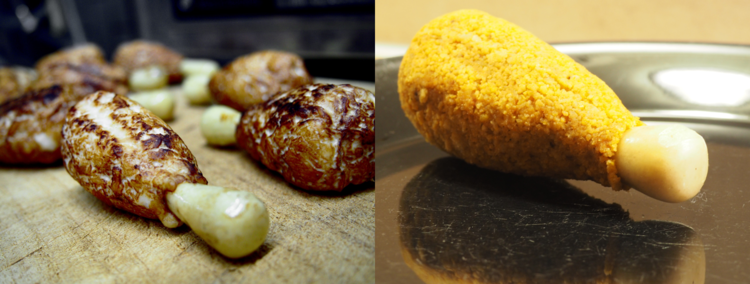Edible and versatile barrier layer for innovative snack and convenience food applications
Abstract
Heat-resistant, water- and gas-impermeable, mechanically resilient and edible barrier layer for the demarcation of differently moist areas in snack and convenience food products.
Fields of application
The barrier layers described can be used in a variety of ways in all foods, but especially in the snack and convenience food sector, where areas of different moisture content need to be separated from one another. In particular, the combination of the properties of water impermeability, edibility, mechanical strength and heat resistance opens up new areas of application and product innovations:
Example "Crumbsticks" (see pictures):
Crumbsticks are fully edible alternatives to the classic chicken drumstick or chicken wing. The product consists of a crispy, edible "bone" made of wheat pastry, which is coated with meat or vegetarian/vegan meat substitutes. This can then be cooked and are suitable for hot consumption. In this case, the "bone" coated with the oleogel is protected by the barrier layer from moisture penetration from the moist food component and the environment during the cooking process and subsequent storage. The crispy breadstick as a bone alternative enables the interplay of two different textures (soft and crispy), which harmonize wonderfully with each other.
Other application ideas:
- Coated baked peas that remain crispy even in soup.
- "Crispy" ingredients for soups and stews that should remain crispy in the soup/stew
- Oven cheese or cheese fondue preparation with crispy crouton inserts
- edible straws that do not soften and are also suitable for hot drinks
- hot fruit preparations with crispy cookie inlay
- soufflés with cookie base
Background
Many processed foods, especially from the snack and convenience food sector, consist of several different components that differ in terms of their taste, consistency, texture, etc. The interaction of the individual components plays an important role in sensory perception, in particular the taste experience, mouthfeel and ultimately also the recognition value of the product. Illustrative examples include yogurt products with solid components (e.g., chocolate flakes or pellets), soups with solid ingredients (e.g., baked peas), or meat products wrapped in dough (e.g., Bifi rolls). Often the different areas are also characterized by different degrees of moisture, and it is important that moisture does not soak into the drier areas of the product.
Problem
In the case of convenience food products with several components, the challenge often lies in separating the different (moisture) areas as permanently as possible, especially during industrial production, transport, storage and final ready-to-eat preparation. If the barrier layer is used as a surface coating, it must also be able to withstand mechanical stress so that it can be touched by the end consumer during production and consumption. Moisture migration from the wetter areas to the drier areas must be avoided, as the quality, stability, taste and mouthfeel of such products will then be seriously affected. In addition, many undesirable chemical and enzymatic reactions take place depending on the moisture content, which can lead to detrimental changes in the taste, color, texture and nutritional value of the food. Barrier layers to separate different areas within a product or to protect the product from the environment are already used in the food industry. Depending on the application, there are various approaches here which normally involve the application of a hydrophobic, water-repellent barrier layer. On the one hand, fatty foodstuffs such as chocolate, which is applied to wafers or other baked goods as a protective layer, can be used for this purpose. In addition, it is possible to apply functional lipid mixtures, either in free form or as an emulsion (e.g. based on fatty acids, triglycerides, waxes, or other lipids). As a result, there are solutions for specific applications, which, however, can only poorly be transferred to other problems, since the functionality is only guaranteed within a narrow application window. So far, there are no solutions that cover the following requirements simultaneously: Water barrier, functionality at high temperatures (heat stability, >50 °C), consumability and mechanical stability.
Solution
A new innovative and universally applicable barrier layer for food applications has been developed at the University of Hohenheim. The consumable protective layer is suitable as a water and moisture barrier and thus prevents moisture migration in snack and convenience foods. According to the invention, this is achieved by oleogels. These are fats that are structured by certain gelling agents. Some of these have already established applications in the food sector, for example in the substitution of animal fats by vegetable alternatives in sausage and meat products, or for reducing oil migration in cream fillings or chocolate. What is new is its use as a coating system. While previous solutions in the food sector have had a maximum of two of the following properties, the new coating combines several properties: it is impermeable to water, heat-resistant, mechanically resilient and at the same time suitable for consumption. By changing the composition or adding additives (such as flavoring or coloring agents), the oleogel coating can be optimally adapted to the specific application. The composition of the oleogel is purely vegetable due to the use of vegetable oils (such as rapeseed, sunflower or olive oil) and ethyl cellulose, which is why these barrier layers are also ideal for vegan and vegetarian products. In addition, the oleogel layers have a shelf life of weeks and can withstand high heat and mechanical stress.
Advantages
- Edible
- Impervious to water
- Very good separation of different moisture ranges in food products
- Universally applicable
- Bio-based from ethyl cellulose and vegetable oil
- Suitable for vegan products
- Heat resistant up to 110 °C
- Flavor can be selectively adjusted by adding flavors
- Targeted adjustment of certain textures and elasticities
- Different application methods possible (e.g. glazing, spraying, etc.) thus integrable into different processes
- Different layer thicknesses possible

